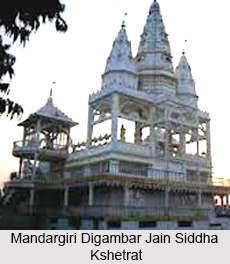 Mandar Giri Digambar Jain Temple located in Bihar is dedicated to Lord Vasupujya Swami. It is famous as the place of penance, Keval Gyan and nirvana of Vasupujya Swami. The Pinchi shaped Guru Mandir was inaugurated at Mandaragiri in a 3 days function held from 9-11 May 2014. The Guru Mandir is dedicated to the Digambar Jain ascetic Acharya 108 Sri Shanthinsagarji Maharaj (1872 - 1955) who revived the Digambar Jain asceticism in the past century. The Guru Mandir is about 81 Feet high and is built over an area of 60X40 feet in 18 months.
Mandar Giri Digambar Jain Temple located in Bihar is dedicated to Lord Vasupujya Swami. It is famous as the place of penance, Keval Gyan and nirvana of Vasupujya Swami. The Pinchi shaped Guru Mandir was inaugurated at Mandaragiri in a 3 days function held from 9-11 May 2014. The Guru Mandir is dedicated to the Digambar Jain ascetic Acharya 108 Sri Shanthinsagarji Maharaj (1872 - 1955) who revived the Digambar Jain asceticism in the past century. The Guru Mandir is about 81 Feet high and is built over an area of 60X40 feet in 18 months.
Location of Mandar Giri Digambar Jain Temple
Jain temple atop a hill (giri) is 62 km from Hebbal, Bangalore towards Tumkur on NH4. This place is off the NH4 by 2-3 kms.
History of Mandar Giri Digambar Jian Temple
According to the history of Mandar Giri, this holy place served as the place of salvation of Lord Vasupujya Swami. This kshetra is related to the three Kalyanka - Tup, Gyan and Moksha of Lord Vasupujya Swami. This is the place where the Lord practiced his penance, achieved his super natural knowledge or Keval Gyan and finally attained his nirvana to become free for the life. Lord Vasupujya Swami also delivered his first precept here.
Construction of Mandar Giri Digambar Jain Temple
The Guru Mandir built at cost of over 1 crore has been made under the guidance of Muni 108 Sri Pranamasagarji Maharaj by Acharya Sri Shanthisagar Guru Mandir Samiti. It can be recalled here that the idol of Acharya Sri Shanthisagarji was unveiled on May 16, 2013 by Acharya 108 Sri Devanandi Muni Maharaj in the presence of Ganadhara Acharya 108 Sri Kunthusagarji Muni Maharaj at Kunthugiri in Maharashtra. After its unveiling the idol of Acharya Sri Shanthisagarji was taken all over India as Ahimsa Shanthi Ratha Yatra and finally arrived at Mandaragiri in Tumkur district of Karnataka.
Temple of Mandar Giri
The temple of Mandar Giri dates back to the ancient time that houses the idol of Lord Vasupujya Swami. The temple is located in front of Mandar Hill railway station and almost 500 meters from a dharamshala located near the hill. The temple has been magnificently carved with artistic designs. The architectural work of the temple depicts the skills of the craftsmen. It has been decorated with glass and sculptor. The temple is also adorned with high pinnacles that enhance the beauty of the temple. The idol of the temple is coral colored and is seated in a padmasana posture. It has been beautifully carved and is worth seeing.
Apart from this there are many other temples located here. A grand Jain temple has been constructed on the hill at the place where Lord Vasupujya Swami attained salvation. It houses the foot images of the Lord and is believed to be almost 3000 years old. The place where Vasupujya Swami attained his Kevalgyan is also located near to the place of salvation. Here also 3 pairs of feet images of the Lord have been installed. The place where Lord Vasupujya Swami accepted his penance is located close by. An exquisite cave temple has been constructed at the place of Nirvana of the Lord. It houses the idol of the Lord and is 5 feet high. The idol is seen in a standing posture.
The temples located in Mandargiri are surrounded by scenic beauty that mesmerizes the pilgrims visiting the place. The temple organises annual functions. The day of salvation of Lord Vasupujya Swami is celebrated in the Bhadraprada Shukla. The birthday celebrations of the Lord Mahavira also known as Mahavir Jayanti is also celebrated in the Chaitra Shukla. The temple has provisions for dharamshalas or rest houses for the pilgrims.
Visiting Information to Mandar Giri Digambar Jain Temple
Mandar Giri Digambar Jain Temple is well connected to road, rail and air. Buses or Taxies are available from Bhagalpur and Banka. The nearest railway station is located in Bhagalpur. The nearest airport is situated in Patna, Ranchi and Kolkata.









